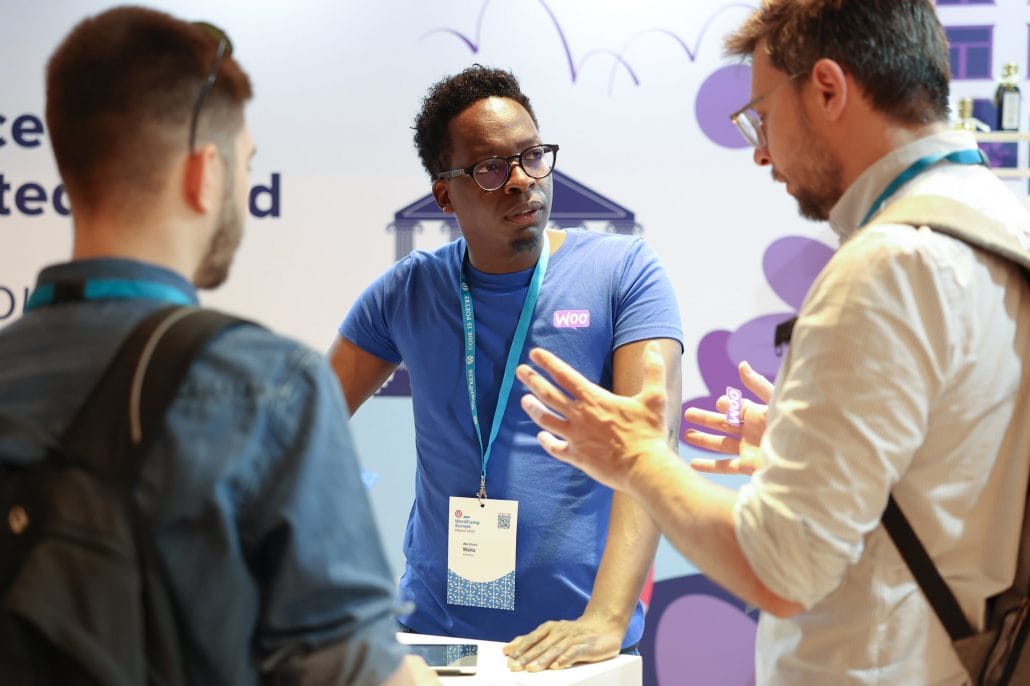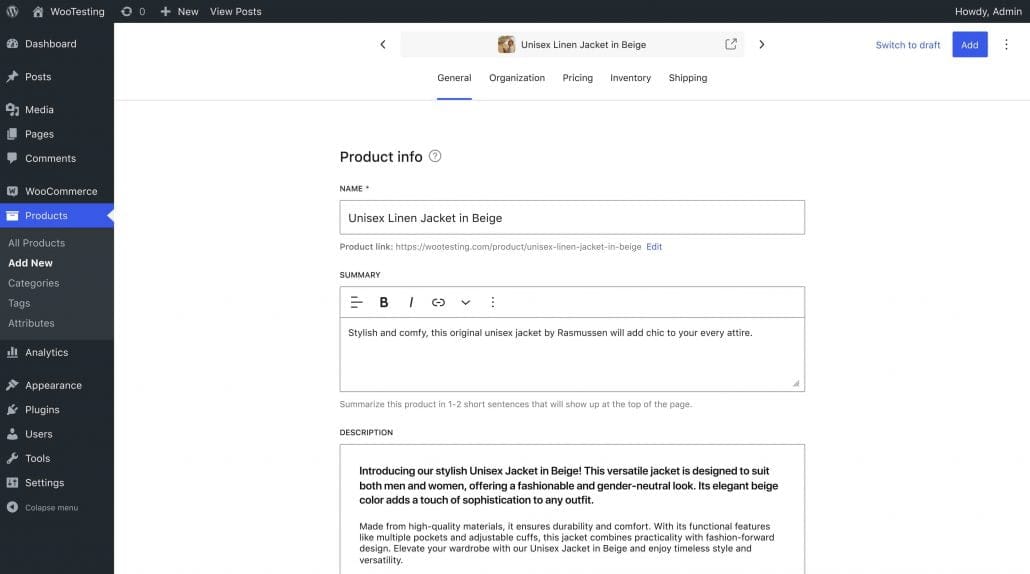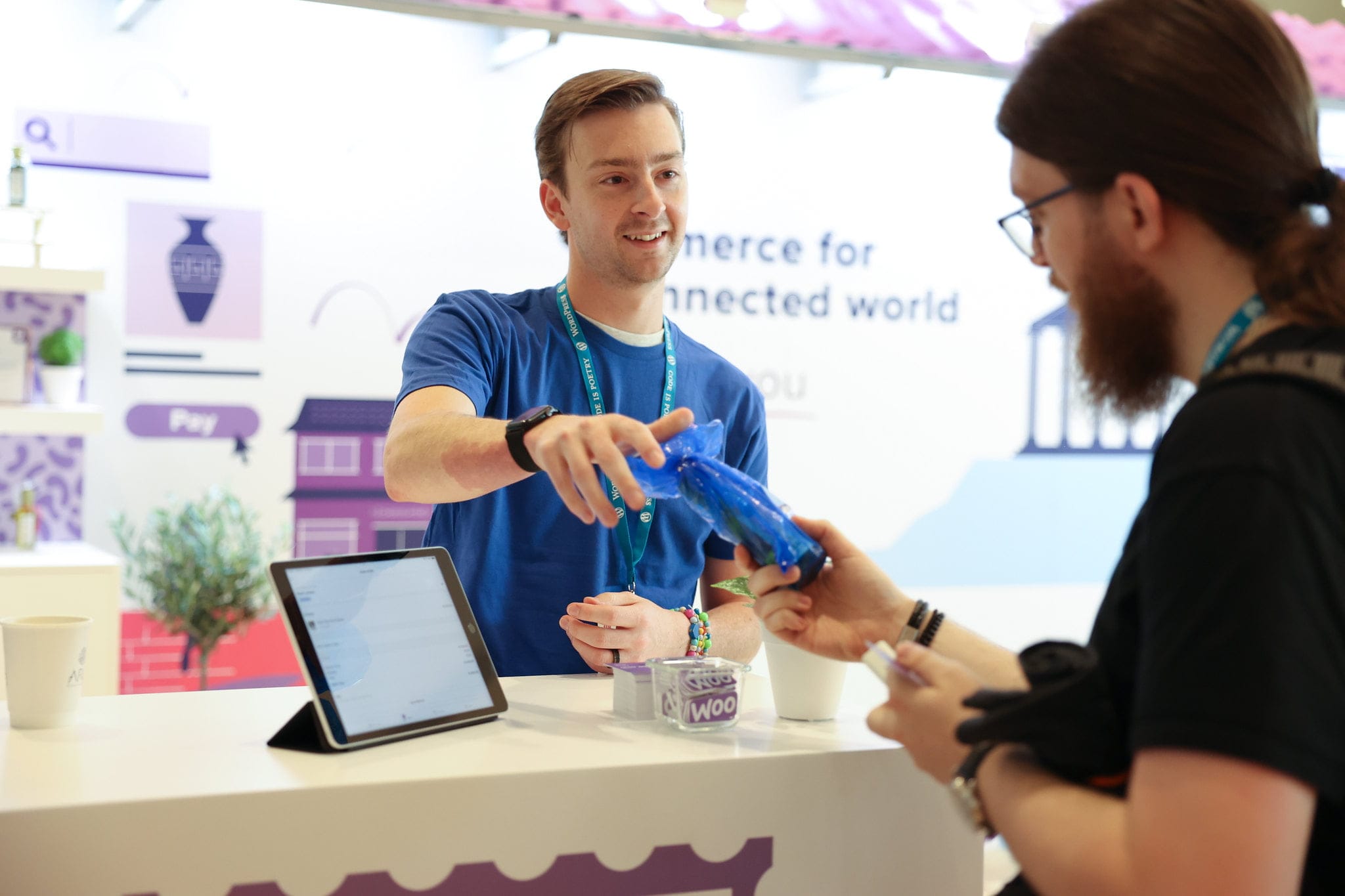Over a thousand people registered for WooSesh 2023, making it the largest audience of the yearly virtual WooCommerce conference which is taking place on October 10 through 12. WooCommerce CEO Paul Maiorana and other members of the WooCommerce team gave a review of the 2023 trends, community highlights, product updates, and product-focused sessions. Here’s our recap!
WooCommerce Statistics
- Over 4.4 million websites use WooCommerce.
- WooCommerce powers 33% of the top 1 million online shops and 8.9% of the internet.
- In the past week alone, WooCommerce was downloaded over 2 million times.
- The WooCommerce marketplace has over 900 products (extensions) and supports 66 languages.
Trends and Insights
- AI in eCommerce: AI is a significant trend, with 91% of surveyed individuals using it in some capacity. This includes chatbots, AI-powered customer support, AI-driven insights for product recommendations, and generative AI tools for product copy. WooCommerce has integrated generative AI tools in Woo Express.
- Data Privacy: With increasing scrutiny on ad companies and evolving laws, data privacy is crucial. WooCommerce emphasizes that customers own their data. The shift is towards owning customer data rather than renting from third parties.
- Cross-Border Selling: More merchants are selling internationally. WooCommerce’s integrations, like Avalara, help simplify challenges like tax compliance.
- Buyer Perspective: Focus on improving load times and the checkout experience.
Feedback from Woo Experts
- Mixed views on the economy due to rising interest rates and geopolitical tensions, but also signs of post-pandemic recovery.
- Increased focus on social responsibility and sustainability.
- Demand for diverse payment options, including local methods, buy now-pay later, tap to pay, and in-person payments.
- Omnichannel selling is essential, with clients seeking ways to reach customers on multiple platforms.
- Emphasis on conversion rate optimization to turn high traffic into sales.
Product Highlights from 2023
- Woo Payments expanded to 38 countries.
- New features include Tap to pay on Android and card readers for an omnichannel shopping experience.
Paul emphasized the importance of community feedback and the role of agencies in shaping WooCommerce’s direction. His intro set the stage for a deeper dive into product updates and sessions.
Payment and Checkout Enhancements
- Introduced «Buy Now, Pay Later» options via Affirm and Afterpay.
- WooPayments, an express checkout solution, was launched, allowing customers to securely purchase from any eligible WooCommerce store.
- New partnerships and integrations were formed, including TikTokShop for native checkout, Canal, Drop Shipping, and channel aggregators like GoDataFeed, GeekSeller, and Said (?) Commerce.
- New payment partners like Sezzle, Pioneer (for APAC customers), and Bankful (for B2B customers) were integrated.
Woo Experts Program
- 88 new agencies from around the world were welcomed.
- The first Woo Experts Awards were held in Europe and North America, with plans to expand to Asia.
- Woo Experts collaborate on product development, design, and roadmap priorities and serve as ambassadors and enterprise experts.
Woo Core and Performance
- High-Performance Order Storage (HPOS), an optimized database solution for WooCommerce, was introduced to handle large volumes of orders, inventory, and customers. With the release of WooCommerce 8.2, it becomes the default for all new stores.
- The focus is on making WooCommerce customization easier through a no-code block-based approach. This includes polishing product blocks and templates and introducing a block-based order confirmation page.
- Cart and checkout blocks will soon become the default experience for all new stores, with increased plugin support for these blocks.
Product Creation Experience
- A new block-based product creation experience was introduced, leveraging the Blocks API for a scalable product creation and editing experience. This was auto-enabled for some new stores as part of WooCommerce 7.9 to gather feedback.
- Plans to add support for variable product management are in the pipeline.
Paul again emphasized the importance of feedback from the community to refine and improve these new features and integrations. The focus remains on enhancing the user experience for shoppers, merchants, and developers alike.
Woo Express
- Woo Express, previously known as Hosted Woo, is an all-in-one WooCommerce shop hosted on WordPress.com. It aims to simplify the signup experience for merchants and comes with integrated extensions and services.
- It serves as a platform to develop, test, and measure new features before integrating them into WooCommerce Core.
WooCommerce Managed Hosting

Community and Developer Engagement
- The WooCommerce community is vast, including volunteers, developers, agencies, entrepreneurs, and millions of merchants.
- A public roadmap was published to provide transparency into WooCommerce’s priorities.
- Documentation has been moved to GitHub, making it open-source and allowing community contributions.
- The Slack community has grown to over 25,000 members, offering a platform for developers and the WooCommerce team to interact.
Woo at WordCamps
- WooCommerce participated in WordCamp Asia in Bangkok, WordCamp Europe in Athens, and WordCamp US in Maryland.
- At these events, WooCommerce showcased its products, collaborated with local merchants, and engaged with the WordPress community.
Merchant Highlights
- Cabin Street, a Canadian apparel company, uses Woo payments for their omnichannel marketing solution.
- Wurmkiste, an Austrian store, shared their experience with WooCommerce, highlighting how the platform solved their business challenges.
- Goodworks Tractors, a tractor supply company, uses WooCommerce to fulfill thousands of orders annually.
- Ghetto Gastro, a New York-based food culture company, uses WooCommerce for their vegan packaged food products available at Target stores.

Paul kept emphasizing the importance of community feedback and collaboration. He urged the audience to test new features, provide feedback, and engage with the WooCommerce team across various platforms.
He concluded by introducing the next presenters, WooCommerce COO Warren Holmes and WooCommerce Content Marketer Laura Nelson, who delved deeper into Woo Express.
What is Woo Express?
- Woo Express is a faster, more delightful, and affordable way to start with WooCommerce.
- It combines improvements to WooCommerce Core with select extensions, all wrapped in a WordPress.com hosting plan. This combination is optimized for new merchants to be competitive in the e-commerce market.
WooCommerce Managed Hosting
Rationale Behind Woo Express
- Research showed that no WordPress hosting provider offers an onboarding experience competitive with SaaS e-commerce platforms.
- When merchants leave WooCommerce, they often leave WordPress entirely, mostly migrating to closed-source platforms like Shopify.
- Woo Express aims to retain these merchants within the WordPress ecosystem.
Improvements and Features
- New onboarding flow in the core, informed by Woo Express.
- Testing a new store personalization experience.
- Consistency improvements in the admin experience between WordPress, WooCommerce, and extensions.
- Defaulted to a block-based theme that includes new cart and checkout blocks.
- The goal is to test new features in a controlled environment and then roll them out in the WooCommerce Core with confidence.
Woo Express Now vs. 12 Months Ago
- Speed: Reduced the onboarding process from 46 clicks to 11.
- Cost: Introduced the Essentials plan at $39/month or $25/month (annual payment), down from the previous $549 annual pricing.
- Features: Introduced a 14-day free trial, added features like gift cards, and integrated social channels for sales through platforms like Facebook, Google, and TikTok. Also emphasized customization capabilities with block themes and extensions like add-ons and product bundles.
Milestones
- Work on Woo Express began in September of the previous year.
- The Essentials plan was launched in March of the current year.
- Free trials were introduced in April.
- By July, Woo Express had reached 1,000 paying subscribers.
Warren then handed over to Laura for a demonstration of Woo Express.
Starting with Woo Express
- The main marketing landing page offers a free 14-day trial for Woo Express.
- Users are prompted to provide basic business details, such as business stage, store name, industry, and location.
- If users are already selling online, options in the task list will prompt them to import existing product data from another store.
Woo Express Home Screen
- The home screen is similar to the WooCommerce experience, but the task list is tailored to the user’s input during sign-up.
- The sidebar is commerce-focused, putting e-commerce functionalities at the forefront.
- Woo Express comes with pre-installed extensions, such as back-in-stock notifications and product recommendations.
- Under marketing, users can create coupons or sell gift cards. However, some marketing extensions are only accessible after launching the store.
Upgrading Woo Express
- Woo Express currently offers two plans: the Essential plan (around $25/month billed annually) and the Performance plan (around $45/month billed annually). The latter is used during the free trial.
- A third plan aimed at enterprise sellers is under consideration.
- The upgrade process takes users to the WordPress.com checkout, where they can complete their purchase.
Future Plans for Woo Express
- Aim to make setting up a store as simple as creating a social profile.
- Introducing AI-assisted setup, including AI-assisted product titles, descriptions, and store customization.
- Using store analytics to provide smart recommendations for shoppers to boost revenue.
- Plans to simplify and speed up the process for merchants to migrate existing shops to Woo Express.
Laura’s presentation showcased the ease of setting up and upgrading within the Woo Express platform, emphasizing its user-friendly interface and features tailored to e-commerce needs.
Product Creation Experience
- Pedro highlighted the importance of products in the commerce experience.
- Emphasized the need for accurate and compelling product information and effective product taxonomy.
- Estimated that over 2 million products are created daily, with 1 million product updates, totaling over 8 million minutes spent on product management tasks daily.
Challenges with the Current Experience
- Recognized that while the current product creation experience has been effective in the past, customer expectations have evolved.
- Identified usability issues with the current experience built around the classic WordPress editor.
- New merchants find the product creation process overwhelming and confusing.
- Difficulties in understanding essential vs. accessory elements, managing product variations, and distinguishing between global and local attributes.
- Mission: WooCommerce aims to improve and rebuild the product management foundation with a commerce-first approach
WooCommerce Product Designer Jaro then delved deeper into the merchant experience. The segment covered the ongoing developments in Woo Express, emphasizing its ease of use and AI integrations. Additionally, the challenges and future improvements in the product creation experience were discussed, highlighting the need to make it more intuitive and aligned with modern merchant needs.
User Research and Insights
- Conducted extensive user research to understand the challenges with the current product creation experience.
- Found the current experience chaotic, with scattered settings and a confusing interface.
- Goals included organizing product settings, creating a commerce-first product creation form, providing a scalable experience, and simplifying the UI.
Demo of the New Experience
- Showcased the new interface inspired by the post and site editor in WordPress.
- Demonstrated the streamlined process of creating a product, including adding product names, descriptions, prices, images, categories, tags, and attributes.
- Highlighted the overhauled variations options, making it easier to add and manage product variations.
Developer Experience
WooCommerce Senior JavaScript Engineer Lourens Schep spoke about the WooCommerce developer experience.
Guiding Principles
- Emphasized the importance of developers as target users.
- Aims to provide a low-complexity API to extend the new product editor.
- Efforts to use PHP for extensions, despite the editor being written in JavaScript.
- Backward compatibility, public brainstorming on GitHub, and comprehensive documentation.
Building on the Block Editor
- The new product editor is built on top of the block editor, with each field and section being its own block.
- Blocks are naturally extendable, allowing for easy structuring and modification of pages.
- Introduced a template API to modify the block editor programmatically.
Tooling and Testing
- Working on a tool to simplify the transition to the block paradigm.
- Encouraged developers to test the new experience and provide feedback.
The segment highlighted the revamped product creation experience, emphasizing its streamlined, intuitive, and extendable nature. The new experience aims to address the challenges of the current system, making it easier for both merchants and developers.
Store Customization and Design
Paul then introduced Patricia Hillebrandt and Tom Cafferkey from the store editing team, emphasizing the importance of updating the product editing experience in WooCommerce.

Motivation and Importance
- The goal is to empower anyone to build their stores without limits.
- Importance of brand and flexibility in design for merchants.
- Great stores need a solid foundation: blocks, patterns, templates, and styles.
Blocks and Block Elements
- WooCommerce now has 116 blocks and block elements.
- New additions include the product collection block and the single product block.
Patterns
- Expanding the Patterns collection to provide merchants with curated designs.
- Patterns allow for faster and more beautiful page building.
Transition from Shortcodes to Blocks
- Shortcodes had usability issues; blocks provide a more customizable experience.
- Almost 90% of WooCommerce pages are now block-based.
- Shortcodes will remain for existing stores not ready for blocks.
Styles
- Styles allow for complete customization from colors to fonts.
- Site-wide changes can be applied easily.
New «Customize your store» Experience
- A new onboarding flow that uses AI to tailor the experience.
- Templates are responsive for all devices.
- Easy navigation and customization with curated patterns.
- Quick color scheme, font, and design changes.
- Customization extends to all store aspects, including shop, product, cart, and checkout pages.
- The new experience is set to be available by the end of 2023, with an initial version releasing in Woo Express this month.
- More features and improvements planned for 2024.
This segment highlighted WooCommerce’s commitment to modernizing store customization and design, making it easier and more intuitive for merchants. The new features and improvements aim to provide a seamless and flexible experience for building and customizing online stores.
In closing, Paul thanked all the presenters and attendees for their time and participation and expressed gratitude to Brian and the WooSesh team for organizing the event. He concluded by expressing excitement for the future of WooCommerce and the collaborative efforts of the community.
Credits
- Pictures by WordCamp Europe 2023




Schreibe einen Kommentar